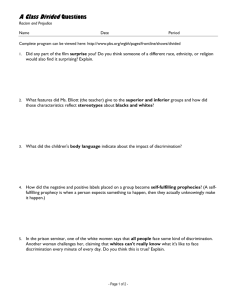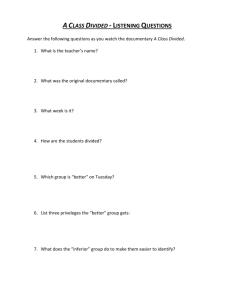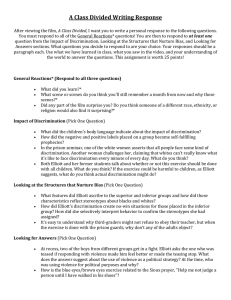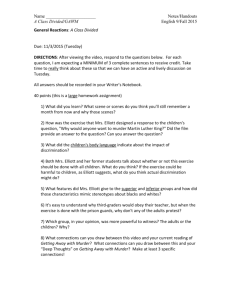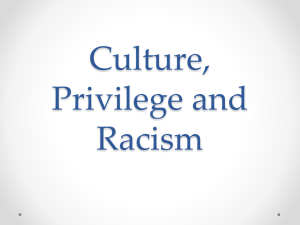File
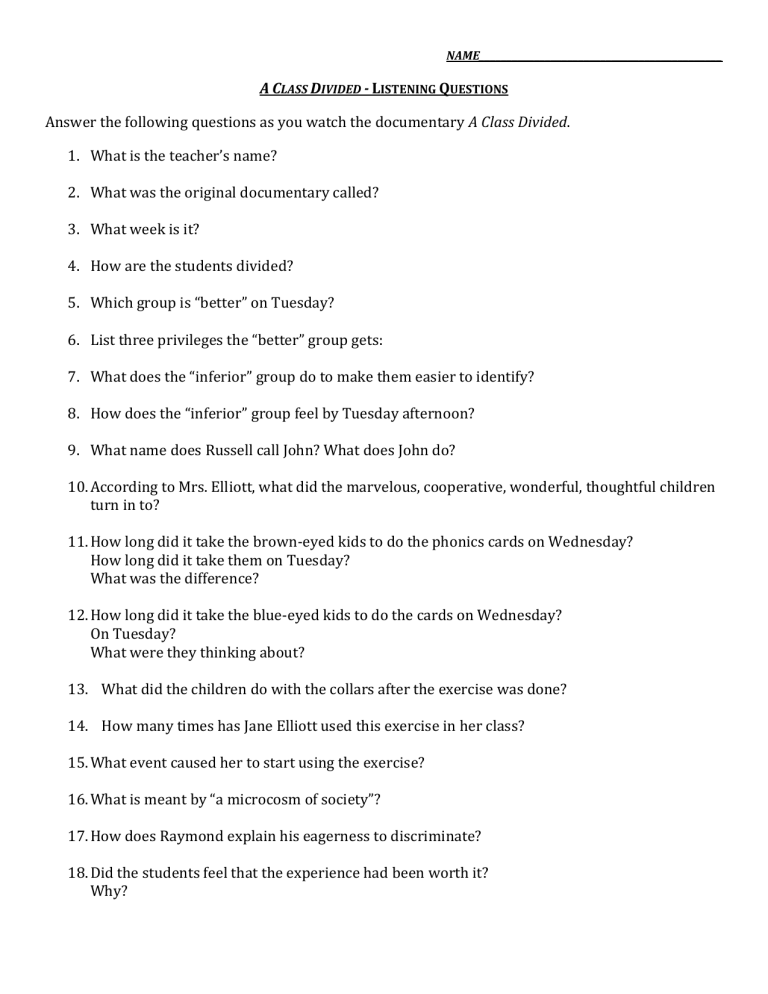
NAME ____________________________________________
A C LASS D IVIDED L ISTENING Q UESTIONS
Answer the following questions as you watch the documentary A Class Divided.
1.
What is the teacher’s name?
2.
What was the original documentary called?
3.
What week is it?
4.
How are the students divided?
5.
Which group is “better” on Tuesday?
6.
List three privileges the “better” group gets:
7.
What does the “inferior” group do to make them easier to identify?
8.
How does the “inferior” group feel by Tuesday afternoon?
9.
What name does Russell call John? What does John do?
10.
According to Mrs. Elliott, what did the marvelous, cooperative, wonderful, thoughtful children turn in to?
11.
How long did it take the brown-eyed kids to do the phonics cards on Wednesday?
How long did it take them on Tuesday?
What was the difference?
12.
How long did it take the blue-eyed kids to do the cards on Wednesday?
On Tuesday?
What were they thinking about?
13.
What did the children do with the collars after the exercise was done?
14.
How many times has Jane Elliott used this exercise in her class?
15.
What event caused her to start using the exercise?
16.
What is meant by “a microcosm of society”?
17.
How does Raymond explain his eagerness to discriminate?
18.
Did the students feel that the experience had been worth it?
Why?
Post Viewing Essay Questions
Create a 5 paragraph essay to answer the following questions about this documentary using this guideline.
General Reactions
What did you learn?
What scene or scenes do you think you'll still remember a month from now and why those scenes?
Did any part of the film surprise you? Do you think someone of a different race, ethnicity, or religion would also find it surprising?
Following Up on the Pre-Viewing Questions
How was the exercise that Elliott designed a response to the children's question, "Why would anyone want to murder Martin Luther King?" Did the film provide an answer to the question? Can you answer the question?
Census categories have changed over time to reflect the complexities of American demographics and identities. Consider how some of the following groups experience racism differently: o o
People who are bi- or multi-racial.
People who have black skin, but are from very different places (e.g., a 13th generation o descendant of African slaves, a recent immigrant from Jamaica, a third generation Cuban, a political refugee from Somalia, etc.).
People "of color" who are not black (e.g., Asians, Pacific Islanders, Latino/as, etc.)
Impact of Discrimination
What did the children's body language indicate about the impact of discrimination?
How did the negative and positive labels placed on a group become self-fulfilling prophecies?
In the prison seminar, one of the white women asserts that all people face some kind of discrimination.
Another woman challenges her, claiming that whites can't really know what it's like to face discrimination every minute of every day. What do you think?
Both Elliott and her former students talk about whether or not this exercise should be done with all children. What do you think? If the exercise could be harmful to children, as Elliott suggests, what do you think actual discrimination might do?
Looking at the Structures that Nurture Bias
What features did Elliott ascribe to the superior and inferior groups and how did those characteristics reflect stereotypes about blacks and whites?
How did Elliott's discrimination create no-win situations for those placed in the inferior group? How did
she selectively interpret behavior to confirm the stereotypes she had assigned?
It's easy to understand why third-graders might not refuse to obey their teacher, but when the exercise is done with the prison guards, why don't any of the adults object?
Looking for Answers
At recess, two of the boys from different groups get in a fight. Elliott asks the one who was teased if responding with violence made him feel better or made the teasing stop. What does the answer suggest about the use of violence as a political strategy? At the time, who was using violence for political purposes and why?
How is the blue eyes/brown eyes exercise related to the Sioux prayer, "Help me not judge a person until
I have walked in his shoes"?

